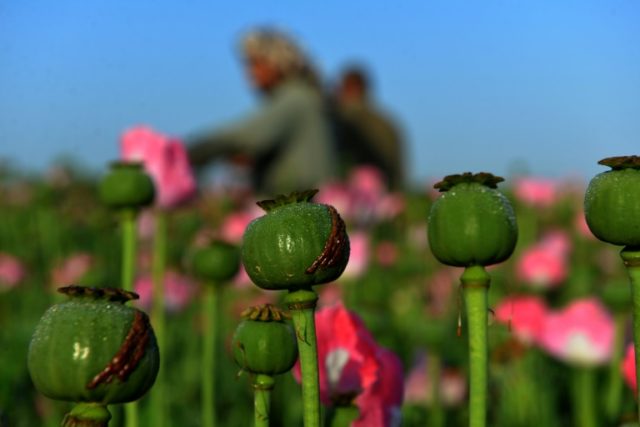The U.S. is no longer interested in developing a “stand-alone” counternarcotics strategy in Afghanistan, choosing instead to back Kabul-led efforts to combat the opium and heroin trade that generates most of the Taliban’s funding.
An American watchdog agency revealed this development on Thursday, noting that opium from Afghanistan contributes in a “minimal” way to the deadly opioid epidemic gripping the United States.
Although President Donald Trump administration’s has dismissed the U.S. counternarcotics strategy, anti-opium efforts funded by American taxpayers continue.
In its latest quarterly report to Congress, the U.S Special Inspector General for Afghanistan Reconstruction (SIGAR) revealed:
Despite its importance…counternarcotics seems to have fallen completely off the U.S. agenda. While the Afghan government is working on a new regional drug strategy, the United States is not. The State Department’s new “Integrated Country Strategy” for Afghanistan no longer includes counternarcotics as a priority, but instead apparently subsumes the issue into general operations there. Meanwhile, the U.S. military says it has no counternarcotics mission in Afghanistan, and the United States Agency for International Development (USAID) says it will not plan, design, or implement new programs to address opium-poppy cultivation.
Alarmed by the “lack of priority for counternarcotics efforts among U.S. and Afghan officials and the lack of success in reducing opium cultivation and production,” American senators have urged SIGAR to “conduct a thorough review of the U.S. government’s current counternarcotics efforts in Afghanistan, including the effectiveness of the current airstrike campaign and the effects of money laundering and corruption on counternarcotics efforts.”
Notwithstanding the lack of a U.S.-led strategy, the U.S. continues to fund Kabul efforts against illicit drugs.
SIGAR reported:
The State Department said a stand-alone strategy would not necessarily improve coordination. Though the Counter Narcotics Working Group has not met since September 2017, according to State, coordination of U.S. government counternarcotics efforts in Afghanistan continues.
Under Trump, the United States has shifted the man focus of its counternarcotics efforts to pressure the Taliban to join “reconciliation talks with Kabul, SIGAR suggested, noting:
According to the State Department’s Bureau of International Narcotics and Law Enforcement Affairs (INL), the United States will not issue a separate counternarcotics strategy that had been under review since 2014. Instead, INL said counternarcotics is interwoven throughout the U.S. Administration’s comprehensive South Asia strategy. The goal of the South Asia strategy is to create conditions for a political process to achieve a lasting, Afghan-led peace.
SIGAR continued to question the effectiveness of the U.S. air campaign to deny the Taliban revenue streams, specifically from opium and heroin.
The watchdog agency told Congress:
As of August 2018, counterthreat-finance operations targeting the Taliban’s revenue streams have destroyed 200 drug-related targets and denied the Taliban approximately $46 million in revenue, according to Department of Defense (DOD) statements to the Wall Street Journal…According to David Mansfield, an expert on Afghanistan’s opium industry, heroin profits and taxes are not as large as U.S. forces estimate and bombing drug labs will have a negligible effect on Taliban revenues. According to DOD, however, Mr. Mansfield’s views are contradicted by CIA classified assessments based on intelligence reviews and the costly changes observed in the tactics, techniques, and procedures of drug-trafficking organizations.
Furthermore, the watchdog agency pointed out that the opium trade is fueling the unprecedented opioid epidemic in the United States that killed about 49,000 people in 2017, making it more lethal than terrorist attacks across the globe that year.
SIGAR noted:
Afghanistan’s opium crisis is worse than ever. The country remains the world’s leading producer of opium, with production hitting an all-time high last year. In addition to increasing the human misery associated with drug abuse, Afghanistan’s narcotics industry helps finance the insurgency, supports criminal networks, fosters public corruption, and undermines the Afghan state. Although this poison contributes a minimal amount to the narcotics epidemic in the United States, Afghanistan’s deadly crop is the largest source of street heroin in Europe and Canada.
A U.S. federal court recently sentenced two Afghan heroin traffickers arrested in Thailand and extradited to 15 years and 10.9 years, respectively, for conspiring to import large quantities of heroin into the United States, SIGAR acknowledged.
U.S. counternarcotics efforts have made “modest or limited impact” on addressing the expanding opium cultivation in Afghanistan and the illicit heroin trade, which reached unprecedented levels last year.

COMMENTS
Please let us know if you're having issues with commenting.